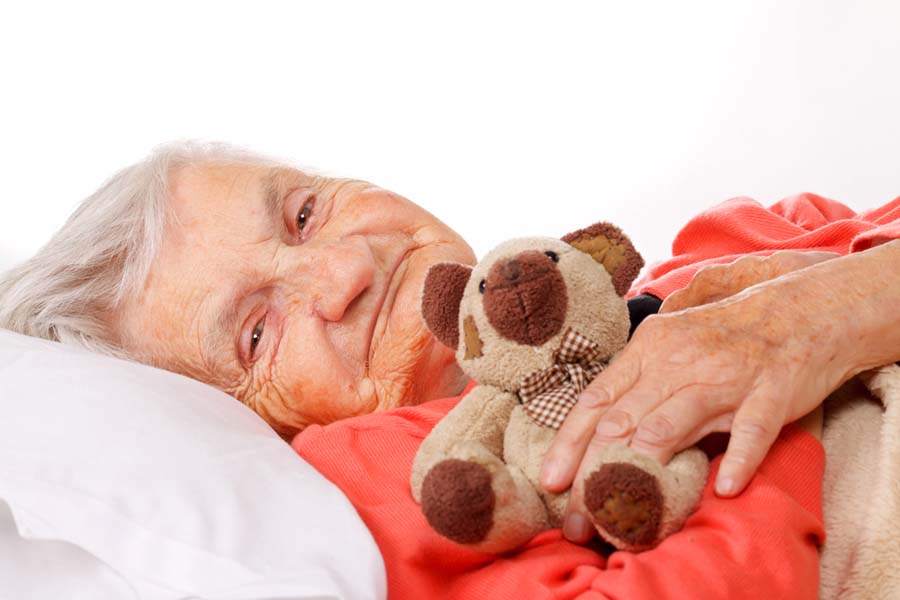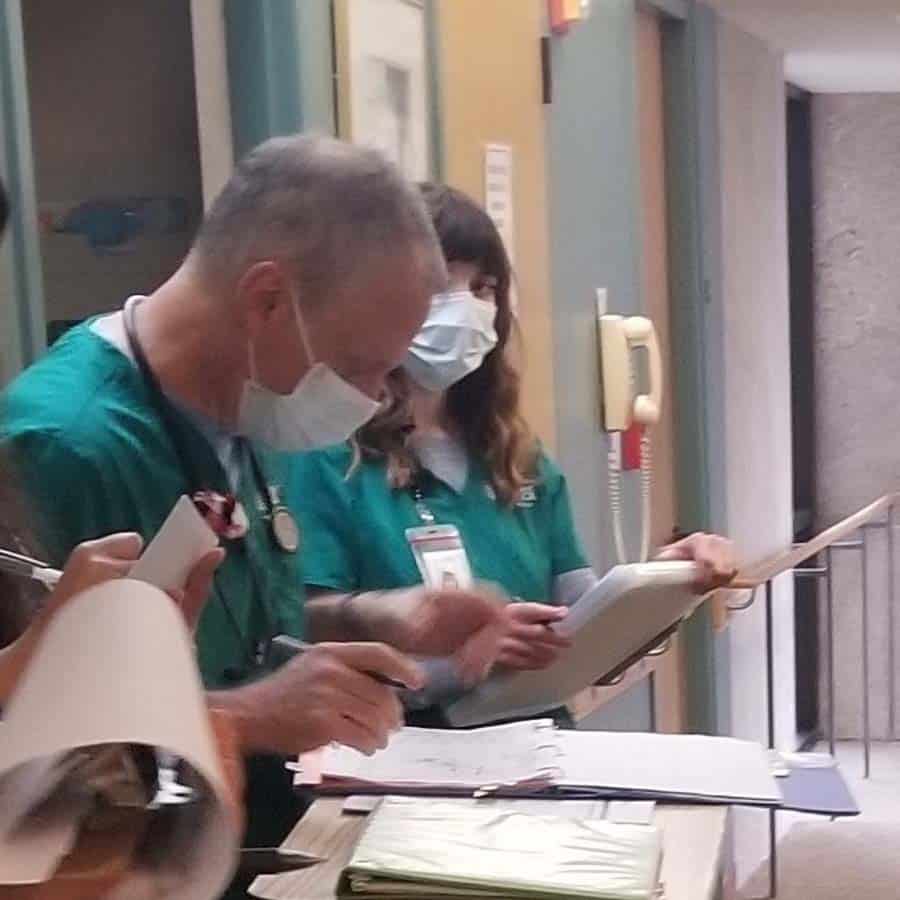Please view our updated COVID-19 guidelines and visiting procedures →.

Opioids are commonly used to relieve pain and shortness of breath in seriously ill people and those at the end of life. While highly effective, these drugs also cause side effects that may limit their use.

Addiction – also called opioid use disorder – is believed by many to inevitably result from prolonged use of opioids, but this concern is unmerited when these important medications are used appropriately by experienced practitioners.
Common opioid side effects such as sedation, constipation, and nausea usually wear off within a few days of use and can be countered with other medications. For example:

Other, less potent but effective pain medications include:

Adjuvant medications are drugs that are not primarily designed for pain relief but can help manage pain by either enhancing the effects of traditional pain medications or providing their own analgesic properties. They are especially useful for neuropathic pain, which often does not respond well to opioids alone.
Adjuvants include medications that either:
Used for:
Used for:

Used for:
Used for:
Used for:

While it is beyond the scope of this blog, all these agents have side effects and toxicities. Anyone using them should:
Pain is often worsened by underlying conditions, such as:
Managing these conditions alongside pain treatment can significantly improve overall well-being.

At Connecticut Hospice, we specialize in expert pain and symptom management for patients facing serious illness and end-of-life care. Our dedicated team understands that effective pain relief is essential to maintaining comfort and dignity.
Whether through outpatient care or our licensed inpatient hospital, we provide the highest level of personalized pain relief and symptom control to enhance quality of life.
Compassionate, expert pain relief is our priority. Let us help you find comfort and dignity at every stage of care.
Call us today at 203-315-7543 to learn more or schedule an appointment.

Respiratory failure -- the inability to breathe well enough to maintain life -- is a very common consequence of a broad spectrum of medical illnesses. In fact, it is the final consequence of any illness that gets bad enough to cause death; people stop breathing and their hearts stop beating. The exception are people who suffer from a heart rhythm abnormality which causes their heart to stop prior to their losing the ability to breathe. In both cases, without further medical intervention, death ensues.
For many, respiratory failure represents a natural death. For example, patients in hospice who are no longer benefiting from treatments directed to the management of their illnesses will get sicker until they eventually suffer respiratory failure. It is the hope of the hospice team that they will be able to enjoy the time that remains to them when while they are in hospice as much as possible before this eventuality.
For others, respiratory failure may happen while they are still experiencing and seeking treatment for a manageable or even curable illness. For example, someone with cancer may be benefiting from treatment directed towards its cure but still suffer pneumonia serious enough to cause respiratory failure. Without urgent respiratory support, that patient will die.

This is where intubation comes in. This straightforward process involves inserting a tube called an endotracheal tube into a patient's trachea, or windpipe, fixing it into place, and attaching it to a machine called a ventilator that will do the patient’s breathing for him or her. This keeps the patient alive while doctors treat the pneumonia – or a wide variety of other problems -- and hopefully cure it, allowing the patient to breathe on their own once again.

In some cases, patients may be treated with so-called noninvasive ventilation, meaning that rather than inserting an endotracheal tube -- or intubating -- a mask that covers the nose and mouth is strapped tightly on the patient and a combination of air and oxygen blown forcibly into the patient's lungs. Called CPAP or BiPAP, this procedure is a bit like driving a car at 60 miles an hour and putting your head out the window face first into the wind. Other people have partial respiratory failure. They can breathe on their own for a period of hours and then become exhausted, after which they are provided noninvasive ventilation to both keep them breathing and give them a rest.

Sometimes, despite being treated for the condition that caused respiratory failure, patients are not able to breathe unassisted and doctors are unable to “extubate” them -- or remove the endotracheal tube. Many such patients are wide awake and enjoying a good quality of life and elect to remain on ventilator support. The intubation tube, however, cannot be left in long term. It has a doughnut shaped balloon at the end, which is inflated after insertion to hold it in place. This causes pressure on the delicate walls of the windpipe. Over the long term, this causes damage and scarring that can dangerously narrow the windpipe. Instead, a tracheostomy is performed. In this procedure, a hole is cut into the windpipe well below the upper trachea, where scarring is most likely, and a short J-shaped tube inserted into it to be connected to the ventilator. This tube can be taken out for cleaning and replaced, improving hygiene. It even allows the placement of a speaking valve that can return the ability to speak out loud to a patient who hasn't been able to do so for a period of days or even weeks.
The decision about whether to accept intubation and ventilator support is highly personal. People who have treatable or even curable serious or life threatening illness may elect to be intubated while undergoing treatment in the hopes that, should they suffer respiratory failure from a complication like pneumonia, they will regain the ability to breathe on their own and resume treatment for their underlying illness. Others, with terminal illness where progression is inevitable may elect to decline intubation and ventilatory support and live out their lives in comfort and die a natural death at home in the company of family and friends while in hospice care.

Many patients receiving care at home from The Connecticut Hospice use CPAP and BiPAP, and some have used invasive ventilation with a tracheostomy at home. All three are options at our Branford inpatient unit.
Should you or someone you know be facing a decision about intubation and ventilatory support, the Connecticut Hospice Stand by Me Palliative Care program can provide additional counseling on treatment options in serious illness. We are here to help.


When caring for a hospice patient, making sure they receive their medications safely and comfortably is essential. Sometimes, swallowing pills can be difficult for these patients due to various conditions, including trouble swallowing, weakness, or other complications. One way to help is by crushing medications, but not all pills are safe to crush. Knowing which medications can be safely crushed and which cannot is crucial to avoid any potential harm.
This guide will cover why some medications can be crushed, which types are generally safe, which are not, and how to crush medications safely.
Many hospice patients have conditions that make swallowing pills challenging, such as:
Crushing medications can help ensure the patient gets their necessary medicine without added stress or discomfort. However, not all medications can be crushed safely, so it’s important to know which ones are suitable for crushing.
While not an exhaustive list, here are some general guidelines on the types of medications that are typically safe to crush:
Certain medications should never be crushed because it can change how they work, cause side effects, or even become dangerous. Here’s a list of common types that should not be crushed:
Here are a few common medications often used in hospice care that should not be crushed:
When crushing medications is appropriate, it’s essential to do it safely to ensure the medication is administered correctly and comfortably. Here’s a step-by-step guide:


If a medication cannot be crushed, there are alternative options:

Caring for a hospice patient involves many special considerations, including how they take their medications. Crushing pills can be a helpful solution, but it must be done with care and the guidance of a healthcare provider. Always double-check which medications can be safely crushed and explore other options if needed. Remember, the goal is to ensure that the patient remains comfortable and receives the best possible care.
If you have any questions about medication safety for your loved one, don’t hesitate to reach out to your hospice team. They are there to support you and provide guidance every step of the way.

Anxiety is a common and normal response to terminal illness in hospice patients. Symptoms of anxiety, listed below, may be related to physical, psychological, social, spiritual, practical, and issues of loss that are prevalent at the end-of-life.
Although many hospice patients will experience fear and other manifestations of anxiety, a formal anxiety disorder, manifested by intense, excessive, and persistent worry and fear about everyday situations, is not common. Some patients, however, may experience severe anxiety related to serious illness; others may even express a desire to hasten dying as a means of avoiding anxiety.
Anxiety is estimated to affect 70% of patients at the end of life and is more common among women, physically impaired patients, and younger patients. Severe anxiety is less common, affecting less than 10% of patients.


Although patients with serious illness commonly experience anxiety, they may not express these feelings, making it important for caregivers to listen for key words that can be a sign of underlying anxiety. Commonly, these words include “worried,” “scared,” “nervous,” and “concerned.”
Clinicians may also screen patients more formally for anxiety (and depression), using validated scales such as the brief Patient Health Questionnaire for Depression and Anxiety (PHQ-4) and the General Anxiety Disorder scale (GAD-7). Patients testing positive may need to be more formally assessed for major depression requiring pharmacologic treatment and monitoring over time for response.
Anxiety may also be due to an unmanaged underlying symptom, especially in patients without a personal or family history of anxiety, and those who do not respond to medications commonly used for its relief (reviewed below). Patients with shortness of breath, for example, can experience severe anxiety, which is relieved with the appropriate use of opioids.
In addition to depression, symptoms of anxiety may overlap with delirium, making careful assessment for this condition important. Patients with delirium, for example, can show poor sleep and inattention or difficulty focusing, which may also be seen in anxiety. Unlike people with anxiety, however, delirious patients typically also have disordered thought (such as hallucinations and delusions), disturbed consciousness (excessive lethargy, hyper-alertness, or both), and altered cognition – which are rarely seen in anxiety.
Once anxiety is identified, treatment begins with sitting with an anxious patient and exploring his or her concerns. Support may be needed from a variety of health professionals:

In patients with anxiety and depression – or those whose anxiety is a manifestation of depression – antidepressant therapy may provide some relief. These include SSRIs such as escitalopram (Lexapro ©) and other agents. Because antidepressants typically require several weeks to take effect, prognosis is relevant to the decision to initiate therapy.
Benzodiazepines such as lorazepam (Ativan ©), clonazepam (Klonopin ©), alprazolam (Xanax ©), and diazepam (Valium ©), are commonly used for the rapid relief of anxiety in hospice patients and can be very effective. The choice of which to use is driven by variations in potency, duration of action, and the presence of active metabolites.
The effects of these drugs can vary greatly between individuals. Lorazepam may also paradoxically increase anxiety or cause agitation and delirium, requiring a switch to another agent.
In summary, anxiety is common in hospice patients. Fortunately, hospice staff are skilled at helping relieve anxiety, using a variety of techniques from counseling to behavioral and lifestyle interventions, to the use of medications. If your hospice-enrolled loved one is – or may be – suffering from anxiety, be sure to notify your hospice team so they can help.

Delirium is a medical condition characterized by inattentiveness (the inability to pay attention in a conversation or directly answer a question) and confusion (such as disorientation or repeatedly asking the same question) and is usually of recent onset (a delirious patient may have been oriented and lucid only days or even hours earlier, and have no history of cognitive impairment). People with delirium may be somnolent and difficult to wake one minute and agitated and hyperalert the next -- so-called ”mixed delirium,” continually somnolent – “hypoactive delirium” – or continually agitated and combative -- “hyperactive delirium.”
Delirium is very common in seriously ill, hospitalized patients – especially in the ICU – and is frequently seen in hospice patients both at home and in the inpatient setting. For those with hyperactive delirium, agitation, and even combativeness can be very distressing for family members and caregivers. Similarly, in a study of patients who recovered from delirium and could recall their experiences, 86% said they were distressed by them, with fear and visual hallucinations being the most common distressing themes.
The most common cause of delirium is an underlying medical condition (for example, an infection like pneumonia or abnormal blood chemistries), which, if successfully treated, causes the delirium to resolve. Delirium may also be caused by unmanaged pain, urinary retention (with an associated distended, painful bladder), long-standing constipation, shortness of breath, and other unpleasant symptoms.

While patients in hospice are typically not treated for their underlying illnesses, hospice providers are expert in relieving unmanaged symptoms, which often leads to a marked improvement in delirium. Because these symptoms can be difficult to diagnose in people who are unable to talk or suffering from cognitive impairment (such as dementia), hospice nurses may use “non-verbal cues” to physical distress such as grimacing, moaning, or agitation, to diagnose distress, and find that delirium calms when appropriate relief is provided. Medications may also cause delirium, which resolves when the medication is stopped. Some of these medications are used in hospice, including benzodiazepines such as lorazepam (Ativan ©) for anxiety, ondansetron for nausea (Zofran ©), SSRIs such as escitalopram for depression (Lexapro ©), corticosteroids for cancer and inflammation (Decadron ©, Prednisone ©) and others.

If unmanaged pain, constipation, urinary retention, or medications are not the cause of delirium in hospice patients, behavioral interventions can help, including assuring a calm, quiet environment, repositioning the patient to a more comfortable position in bed, having family and friends provide reassurance at the bedside, playing music, or providing recreational activities such as games or TV.

Antipsychotic medications may also be used for the management of delirium in hospice patients, including haloperidol (Haldol ©), risperidone (Risperdal ©), olanzapine (Zyprexa ©), quetiapine (Zyprexa ©), and others. When these medications are necessary, engagement of family members is critical to decision-making. Antipsychotics have a mixed record in relieving delirium but offer the advantage of potentially calming patients with hyperactive delirium without sedation. Families are educated that delirium may persist while a trial of antipsychotic agents is used in the hope of providing relief.
At CT Hospice, delirious patients have been successfully managed with haloperidol, olanzapine, and quetiapine, allowing them to meaningfully engage with families – though sometimes considerable confusion, inattention, and even some agitation persist – during their last days of life.
When antipsychotics don’t work, families are asked to consent to sedation as a last resort in settling an agitated patient. Some families, wanting to relieve agitation as quickly as possible, may elect to forgo antipsychotics and use sedation earlier.
In hyperactive delirium at the very end of life – “terminal agitation” – antipsychotics rarely offer the possibility of relieving agitation while also maintaining consciousness. Patients only hours from death, pale, sometimes tinged blue, with very low blood pressure, oxygen levels, and pulse, are usually deeply unconscious and show only brief signs of delirium. Often, this happens while they are being cleaned and repositioned, and is manifest by their opening their eyes wide and adopting a frightened expression. One means of managing this is to premedicate with an opioid such as morphine to ensure they are not having pain while being cleaned. Sedation with a barbiturate or benzodiazepine such as phenobarbital, lorazepam (Ativan ©), or diazepam (Valium ©) may also be appropriate.
Notably, delirium may be confused for anxiety, a psychiatric or emotional – rather than a medical condition. Typically, anxious people can say they are anxious, unlike people with delirium. For example, they may fear death, have spiritual concerns, worry about leaving loved ones behind, or have financial or other practical concerns. Delirious people, being inattentive and confused, usually speak in unintelligible, garbled or nonsensical terms – making anxiety unlikely. A future blog will explore anxiety more closely.

Many people who are considering hospice care ask the question: “Can I continue to see my doctor after I enroll in hospice?” This guide will answer that question, and clarify Medicare’s seemingly complicated rules in hopes of promoting your ongoing involvement with the doctor who has served you so well.
This guide focuses on Medicare, which is the insurer for most people in hospice -- the Medicare Hospice Benefit (MHB). If your hospice care is not covered by the MHB, you may want to contact your insurer directly to find out the rules.
Usually, the doctor that people want to continue to see is the specialist who treated them for the condition that led to hospice enrollment, for example, a cardiologist for people with heart disease or an oncologist for people with cancer.
It is possible for your specialty doctor to remain involved in your care, provided he or she agrees to act as your “hospice primary attending.” This is the doctor who works with the hospice interdisciplinary team (IDT) to guide care – mostly by providing medication orders over the phone to the hospice nurse who comes to your home.
If you want your specialty doctor to remain involved in your care, ask him or her to agree to be your hospice primary attending – but remember that most of his or her involvement will be in directing your care over the phone with your hospice team, not in seeing you in the office. They are also unlikely to order blood tests, x-rays, or CT scans for you, as those tests will not contribute to your comfort after you are no longer being treated medically. (And you may be billed for them if they are ordered.)

You can still see your regular – non-hospice – primary care doctor while you are in hospice, or a specialty doctor that you see for a condition unrelated to hospice. For example, if you are enrolled in hospice for lung cancer but also suffer from rheumatoid arthritis. It is important to understand, however, that the Medicare Hospice Benefit will not pay for primary or specialty care, or medications, for services unrelated to your hospice diagnosis – the condition that led to your enrolling in hospice, like heart disease or cancer. However, Medicare Part B (which pays for office visits) and Medicare Part D (which covers prescription medications) will usually still pay for these services – though you should notify the non-hospice specialist and primary care doctor that you are enrolled in hospice and covered by the MHB before making an appointment.
If you decide not to ask the specialty doctor who provided care for the condition that led to your enrolling in hospice to act as your hospice primary attending, or if he or she chooses not to do so, your hospice care will be assumed by the hospice medical director or another physician employed by or contracted with hospice. For example, if your oncologist declines to be your hospice primary attending, the hospice MD becomes your doctor. If you still decide to see your oncologist, the MHB will not cover the visit, and you may be billed for it.

In summary, your care may continue to be directed by your specialty doctor if he or she agrees to be your hospice primary attending, though that will probably not involve office visits, blood tests, x-rays, or CT scans. If your doctor declines that role, your care will be overseen by a hospice doctor. Doctor visits and medications that are unrelated to your hospice diagnosis are not covered by the Medicare Hospice Benefit, but are generally still covered by Medicare Parts B and D.
Feel free to call the admissions department at The Connecticut Hospice, Inc., at 203-315-7540 if you have questions.
As a not-for-profit, we depend on generous donors to help us provide customized services and therapies that aren’t completely covered by Medicaid, Medicare, or private insurance.
Please make a gift to help us sustain the highest standard of care.
Admissions may be scheduled seven days a week.
Call our Centralized Intake Department: (203) 315-7540.